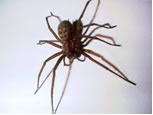
Common Pests – Spiders
The two most commonly seen spiders in houses in the UK are:
the House Spider
and the Daddy Long Legs Spider
Description
Female House spiders are 9-10mm in size, and males are 6-9mm (not including leg span). They are brown and hairy with long legs. The leg span of this spider can reach up to 60mm. Males have a slimmer abdomen and longer legs. The bodies of Daddy long legs spiders are approximately 10mms and they have very thin long legs. They are almost transparent when young and as they grow their bodies become a pale brown colour.
Lifecycle and Habits
The House spider hangs upside down in its web, which is made up of trip lines that extend vertically and horizontally throughout the web to entrap prey. The web of the house spider is irregularly shaped and has a scaffold-type arrangement. Prey gets caught in the trip lines, which direct it into the centre of the web. It is then killed by a bite and subsequent venom injection.
The female produces approximately 250 eggs, which are placed in a silken sac in the centre of the web. Under good conditions, depending on temperature and humidity, several egg sacs may be present in the web at the same time. The eggs will hatch after 7 to 10 days, and the spiderlings will remain in the silken sac for one moult. After the first moult, the spiderlings emerge from the sac and “balloon” to new locations by spinning silk threads. They can live for 20 days or longer without eating. Consequently, the survival rate of the house spider is fairly high.
Spiderlings construct larger webs as they mature and require more food. Webs are frequently abandoned in sites that do not yield prey, and new webs are constructed.
Daddy long legs spiders are found all year and have similat habits. They are found throughout the UK although especially common in the south.
They hang upside-down in a flimsy web of criss-cross threads in the corner of a ceiling. If you disturb them they shake and gyrate their bodies so quickly that they become a blur.
The females carry their eggs in a loose bundle
What Spiders Eat
These spiders mainly prey upon small insects such as fruit flies and mites.
Problems Linked to spiders
House spiders are harmless and more of a nuisance than a health risk.
Preventing or dealing with an infestation
Because these spiders usually construct their webs in open areas of buildings, the easiest way to manage infestations is by non-chemical methods. Removal is the most effective means of managing an infestation. Spider webs and egg sacs can be easily removed with a vacuum.
Preventative measures should also be taken to ensure that spiders cannot enter structures. Cracks in exterior walls should be sealed, and weather-stripping should be tightly fitted around door frames. Exterior lights attract insects, which, in turn, attract spiders to prey. Therefore, mercury vapour lights should be replaced with sodium vapour lights, which are less attractive to insects. Also, exterior lights should only be used when needed.
Professional help
It may be advisable to contact a reputable Pest Control company, either for advice, or to carry out a professional treatment. The British Pest Control Association has a list of its member companies on its website, for all areas.